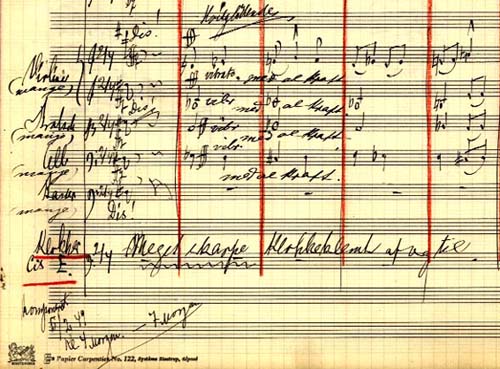Aspects & Points
Untraditional Tempo and Mood Designations
Langgaard often wrote untraditional mood instructions in his works regarding the nature, tempo and performance of his
music. As a rule - not always with equal success! - he tried to express himself in Italian, though Danish expressions are
also found. As examples of this Italian nomenclature can be mentioned the value-laden expressions to be found in String
Quartet No. 3. These are such 'negative' designations as Poco allegro rapinoso (rapaciously) and Scherzoso
schernevole (jestingly). Words such as furioso (wildly) and frenetico (frenziedly) are also often met
with in Langgaard's musical scores. At the more peaceful end of the scale we find words such as engleagtigt
(angelic), religioso (religiously) and glorioso (gloriously).
Langgaard's sense of humour is exemplified by his Esbjergsangen (Esbjerg Song), at the head of which he wrote
the instruction "Havnefrisk! (Harbour-fresh!)" (Esbjerg is a port).
Reproduced below is an excerpt (the string parts) of the first page of the manuscript score of Symphony No. 15 Søstormen (The Tempest) (1949). In this case Langgaard wanted the music to be "white-hot", and therefore required the string section to play "with all their might" (fff).
Note also the the unisonant "D sharp!" in the first bar. When Langgaard writes the key signature in letters, he does so to draw attention to the symbolism: in this case a reference to the prefix dis- in words such as 'disharmony', etc.
Finally, note the dating at the bottom. The whole symphony (with the exception of the finale, which is identical with a choral work composed 12 years earlier) was sketched out in the course of three hours early one February morning in 1949. The fair copy of the score was ready 10 days later.

![]()